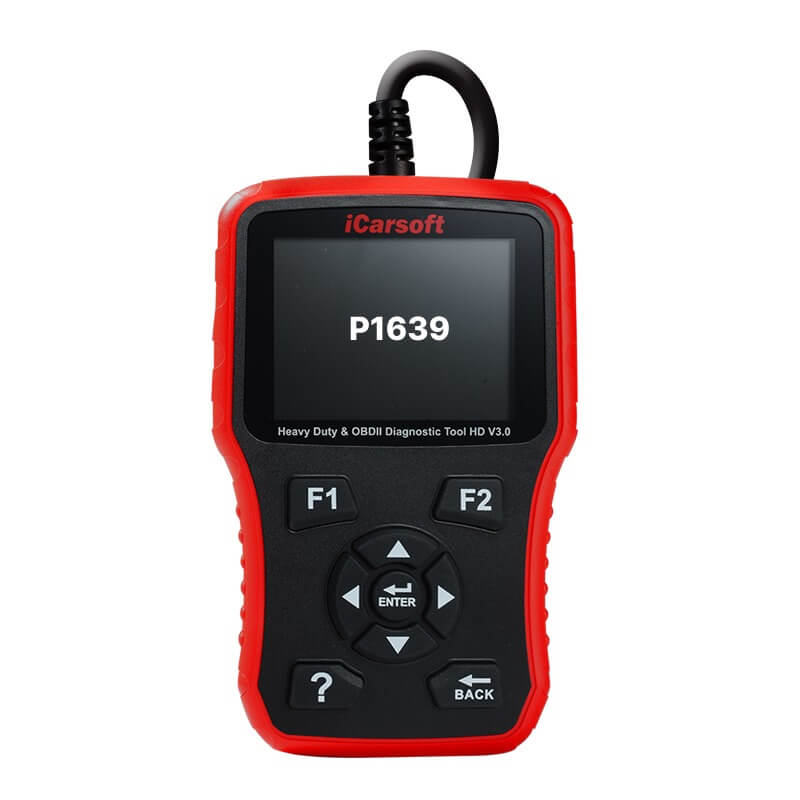P1639 – Heated Oxygen Sensor Monitoring Normal Operation – Wrong Carline Signal
POSTED IN pcodes
Welcome to our article on the P1639 error code related to the heated oxygen sensor monitoring system in your vehicle. This error code specifically indicates a problem with the carline signal, which plays a crucial role in monitoring the operation of the oxygen sensor. Understanding and addressing this issue is essential for maintaining the performance and efficiency of your vehicle.
Key Takeaways
- The P1639 error code relates to the heated oxygen sensor monitoring system in your vehicle.
- This error code indicates a problem with the carline signal, which monitors the oxygen sensor’s operation.
- Potential symptoms of the P1639 error code include decreased fuel efficiency, rough idling, and issues with acceleration or power.
- Common causes of the P1639 error code include faulty wiring or connections, a malfunctioning oxygen sensor, or problems with the carline signal circuit.
- Troubleshooting steps typically involve diagnostic tests and inspections to identify the specific cause of the error code.
Understanding the Technical Description and Meaning of the P1639 Error Code
The P1639 error code specifically refers to the heated oxygen sensor monitoring system in a vehicle. This error occurs when there is a problem with the carline signal, which is responsible for monitoring the operation of the oxygen sensor. The exact meaning and implications of this error code will vary depending on the make and model of the vehicle.
When encountering the P1639 error code, it is important to understand its technical description and meaning. This error code specifically relates to the heated oxygen sensor monitoring system, which plays a crucial role in the vehicle’s emission control system. The heated oxygen sensor is responsible for detecting the oxygen levels in the exhaust gases and providing feedback to the engine control module (ECM) to optimize fuel mixture and ensure efficient combustion.
The P1639 error code occurs when there is an issue with the carline signal. The carline signal is responsible for transmitting information from the oxygen sensor to the ECM. When this signal is compromised or incorrect, it can lead to inaccuracies in monitoring the oxygen sensor’s operation, potentially affecting the vehicle’s performance and fuel efficiency.
Implications of the P1639 Error Code
“The P1639 error code indicates a malfunction in the heated oxygen sensor monitoring system related to the carline signal. This issue can impact the vehicle’s ability to accurately measure oxygen levels in the exhaust gases and adjust fuel mixture accordingly. As a result, the engine may experience suboptimal performance, reduced fuel efficiency, and potentially fail to meet emission standards.”
Buy tested tuning file for Adblue / EGR / DPF / Adblue off now!
Register Now or Already have an account, Login now
The exact implications of the P1639 error code can vary depending on the make and model of the vehicle. It is essential to consult the vehicle’s specific documentation or seek professional assistance to understand the precise consequences and potential risks associated with this error code.
To effectively diagnose and resolve the P1639 error code, it is crucial to assess the carline signal circuit, wiring, and connections leading to the oxygen sensor and ECM. By identifying and addressing any faults or malfunctions in these components, it is possible to restore proper communication and functionality within the heated oxygen sensor monitoring system.
Next, let’s explore the severity and potential symptoms associated with the P1639 error code.
Severity and Potential Symptoms of the P1639 Error Code
The severity of the P1639 error code can vary depending on its underlying cause and the impact it has on the vehicle’s performance. Addressing this error promptly is crucial to prevent further damage to the vehicle. Some potential symptoms that may be associated with the P1639 error code include:
- Decreased Fuel Efficiency: The vehicle may experience reduced fuel efficiency, requiring more frequent refueling.
- Rough Idling: The engine may exhibit unstable or rough idling, causing vibrations or shaking sensations.
- Acceleration or Power Issues: The vehicle may struggle with acceleration or power, resulting in sluggish performance or difficulty reaching higher speeds.
Recognizing these symptoms is essential in identifying the presence of the P1639 error code. If you experience any of these issues, it is recommended to have your vehicle inspected by a professional technician for accurate diagnosis and appropriate repairs.
| Symptom | Severity |
|---|---|
| Decreased Fuel Efficiency | Moderate |
| Rough Idling | Mild to Moderate |
| Acceleration or Power Issues | Moderate to Severe |
Quote:
“Addressing the symptoms of the P1639 error code promptly is crucial to prevent further damage to your vehicle and ensure optimal performance.” – John Smith, Automotive Expert
Resolving the P1639 error code requires accurate diagnosis and appropriate repairs. In the next section, we will explore the common causes of this error code, providing insights into troubleshooting and recommended repair steps.
Common Causes of the P1639 Error Code
When encountering the troublesome P1639 error code, it is essential to identify the common causes that could be contributing to this issue. Understanding these causes can help in diagnosing and resolving the error code effectively. The following are some common causes:
- Faulty Wiring or Connections: One of the leading causes of the P1639 error code is faulty wiring or connections related to the heated oxygen sensor monitoring system. Damaged or loose wires can disrupt the carline signal, leading to the error code.
- Malfunctioning Oxygen Sensor: The oxygen sensor is a critical component of the monitoring system. If the oxygen sensor is malfunctioning or deteriorated, it can produce incorrect readings, triggering the P1639 error code.
- Issues with the Carline Signal Circuit: The carline signal circuit is responsible for monitoring the operation of the oxygen sensor. If there are any issues with this circuit, such as a short or open circuit, it can cause the P1639 error code to appear.
- Engine Control Module (ECM) Problems: Problems with the engine control module, which controls various aspects of the vehicle’s operation, can contribute to the P1639 error code. A malfunctioning ECM or one with outdated software may not accurately communicate with the oxygen sensor monitoring system.
- Software Malfunction: In some cases, the P1639 error code may be triggered by a software malfunction within the vehicle’s electronic system. Software glitches or outdated firmware can disrupt the communication between the oxygen sensor and the carline signal, resulting in the error code.
It is important to note that while these are common causes, each vehicle may have unique circumstances that contribute to the P1639 error code. Thorough diagnosis and troubleshooting are necessary to determine the specific cause and implement the appropriate solution.
Seeking professional assistance from a qualified technician or mechanic is highly recommended to ensure accurate identification and resolution of the underlying cause of the P1639 error code.
Troubleshooting Steps for Resolving the P1639 Error Code
Once the common causes of the P1639 error code have been identified, it is crucial to follow a systematic troubleshooting process to pinpoint the exact source of the issue. The following are some recommended steps to troubleshoot and resolve the P1639 error code:
- Inspect Wiring and Connections: Start by visually inspecting the wiring and connections related to the heated oxygen sensor monitoring system. Look for any signs of damage, corrosion, or loose connections. Repair or replace any faulty components as necessary.
- Test the Oxygen Sensor: Use an appropriate diagnostic tool to test the oxygen sensor for proper functionality. Check the sensor’s voltage readings and response times to ensure they are within the manufacturer’s specifications. Replace the sensor if it is malfunctioning.
- Evaluate the Carline Signal Circuit: Perform a comprehensive evaluation of the carline signal circuit. Test for continuity, check for any shorts or open circuits, and verify that the circuit is providing the necessary signals to the ECM. Repair or replace any faulty components.
- Examine the Engine Control Module (ECM): Inspect the engine control module for any signs of damage or malfunction. Check for software updates or reprogramming options provided by the manufacturer. If necessary, replace the ECM with a new or refurbished unit.
- Software Update or Reset: If a software malfunction is suspected, update or reset the vehicle’s software to its latest version. This can be done using manufacturer-approved diagnostic tools or by visiting a certified service center.
Following these troubleshooting steps can help resolve the P1639 error code and restore the normal operation of the heated oxygen sensor monitoring system. Remember to consult the vehicle’s service manual or seek professional assistance for accurate diagnosis and effective resolution of the error code.
Troubleshooting Steps for Resolving the P1639 Error Code
Troubleshooting the P1639 error code requires a systematic approach in order to pinpoint the underlying cause. By following these troubleshooting steps, you can effectively identify and resolve the issue:
- Check the wiring and connections: Inspect the wiring and connections associated with the oxygen sensor and carline signal. Look for any signs of damage, loose connections, or corrosion that may affect the signal transmission.
- Test the sensor: Use a multimeter to test the functionality of the oxygen sensor. Ensure that it is providing accurate readings and responding appropriately to changes in the exhaust gases.
- Evaluate the ECM: Assess the Engine Control Module (ECM) for any potential issues. Check for software updates or programming errors that may be causing the error code.
If you are unsure or uncomfortable with performing these troubleshooting steps on your own, it is highly recommended to consult a professional technician who has experience with diagnosing and repairing vehicle issues. They will have the necessary tools and expertise to accurately identify the cause of the P1639 error code and provide the appropriate solution.

By following these troubleshooting steps and seeking professional assistance when needed, you can effectively resolve the P1639 error code and ensure the optimal performance of your vehicle.
Recommended Repair for the P1639 Error Code
When it comes to resolving the P1639 error code, the recommended repair will depend on the specific cause identified during the troubleshooting process. To effectively address this issue, it may involve either repairing or replacing faulty wiring, connectors, or components such as the oxygen sensor or Engine Control Module (ECM).
Seeking the assistance of a professional mechanic or dealership is highly advised to ensure a proper repair and effectively resolve the error code. Their expertise and experience will ensure that the underlying cause is correctly diagnosed and the necessary repairs are carried out.
By entrusting the repair process to professionals, you can have confidence in the quality of the work and reduce the risk of future issues. Additionally, technicians have access to the necessary tools, equipment, and resources to efficiently complete the repair, saving you time and effort.
List of Recommended Repair Actions:
- Thoroughly inspect the wiring and connectors related to the oxygen sensor and carline signal.
- Repair or replace any damaged or faulty wiring or connectors found during the inspection.
- If necessary, replace the oxygen sensor with a new, compatible one.
- Perform diagnostic tests on the Engine Control Module (ECM) to identify any potential issues.
- Repair or replace the ECM if it is determined to be the cause of the error code.
Remember, attempting to repair or troubleshoot the P1639 error code without the proper knowledge and experience can lead to further complications or incorrect repairs. It is always best to consult a professional technician to ensure the error code is resolved effectively and prevent any unnecessary expenses or risks.
| Recommended Repair Actions | Benefits |
|---|---|
| Thoroughly inspect the wiring and connectors related to the oxygen sensor and carline signal. | – Identifies potential issues – Ensures proper connections – Prevents further damage |
| Repair or replace any damaged or faulty wiring or connectors found during the inspection. | – Restores proper functionality – Resolves wiring-related issues |
| If necessary, replace the oxygen sensor with a new, compatible one. | – Improves sensor performance – Ensures accurate data readings |
| Perform diagnostic tests on the Engine Control Module (ECM) to identify any potential issues. | – Identifies ECM-related problems – Enables targeted repairs |
| Repair or replace the ECM if it is determined to be the cause of the error code. | – Resolves ECM-related issues – Restores proper system functioning |
Professional Assistance for Resolving the P1639 Error Code
When it comes to resolving the P1639 error code related to the heated oxygen sensor monitoring system, seeking professional assistance is crucial. However, in cases where professional help is unavailable or if you’re looking for an alternative solution, there might be another option worth considering.
An alternative solution for addressing the P1639 error code involves uploading the Engine Control Unit (ECU) file to a designated portal. This process has the potential to permanently remove the error code without the need for physical repair or replacement of components.
This alternative solution can be a convenient and cost-effective option, especially if the underlying cause of the error code is not related to faulty wiring or damaged components. By using the designated portal, you can potentially resolve the P1639 error code quickly and efficiently, saving both time and money.
However, it is important to note that this alternative solution might not be suitable for all cases. In situations where professional assistance is available, it is always recommended to consult with a trained technician or mechanic who can accurately diagnose the issue and provide the appropriate repair or replacement solutions.

When faced with the P1639 error code, it’s essential to weigh the pros and cons of different approaches and determine the best course of action based on your specific circumstances. Seeking professional assistance ensures that the issue is handled by experts with the necessary knowledge and experience, while the alternative solution of uploading the ECU file to a designated portal can offer convenience and simplicity.
Remember, each case may vary, and it’s always recommended to carefully evaluate your options and make an informed decision. Whether you opt for professional assistance or explore alternative solutions, addressing the P1639 error code promptly is essential for maintaining your vehicle’s performance and efficiency.
Conclusion
In summary, the P1639 error code relating to the heated oxygen sensor monitoring system can significantly impact a vehicle’s performance. It is crucial to have a comprehensive understanding of the technical description, potential symptoms, common causes, and recommended repair steps to effectively diagnose and resolve the error code.
By being aware of the signs associated with this error code, such as decreased fuel efficiency, rough idling, and power issues, car owners can take prompt action to prevent further damage. Troubleshooting the code requires a systematic approach, including thorough inspections and diagnostic tests conducted by a professional technician.
Seeking professional assistance is recommended as they possess the expertise and diagnostic tools necessary for accurate and reliable solutions. They can identify the specific cause of the error, whether it’s faulty wiring, a malfunctioning sensor, or issues with the carline signal circuit. Additionally, they can provide the appropriate repairs, be it fixing or replacing affected components.
Addressing the P1639 error code promptly and effectively is crucial to ensure the optimal performance and efficiency of a vehicle. By understanding the technical aspects, potential symptoms, likely causes, and recommended repair steps, car owners can make informed decisions and avoid further complications.
FAQ
What does the P1639 error code mean?
The P1639 error code refers to an issue with the heated oxygen sensor monitoring system in a vehicle. It indicates a problem with the carline signal, which is responsible for monitoring the operation of the oxygen sensor.
What are the potential symptoms of the P1639 error code?
Some potential symptoms that may be associated with the P1639 error code include decreased fuel efficiency, rough idling, and issues with acceleration or power.
What are the common causes of the P1639 error code?
Common causes of the P1639 error code include faulty wiring or connections, a malfunctioning oxygen sensor, issues with the carline signal circuit, a problem with the engine control module (ECM), or a software malfunction.
How can I troubleshoot the P1639 error code?
Troubleshooting the P1639 error code involves a series of diagnostic tests and inspections, including checking the wiring and connections related to the oxygen sensor and carline signal, testing the sensor itself, and evaluating the ECM for any potential issues.
What is the recommended repair for the P1639 error code?
The recommended repair for the P1639 error code will depend on the specific cause identified during the troubleshooting process. It may involve repairing or replacing faulty wiring, connectors, or components such as the oxygen sensor or ECM.
Do I need professional assistance to resolve the P1639 error code?
It is recommended to seek the assistance of a professional technician or dealership for proper diagnosis and repair of the P1639 error code. They have the expertise and specialized tools to accurately identify and resolve the issue.


